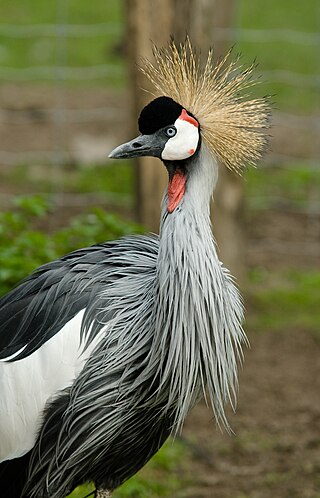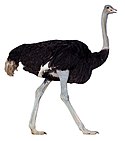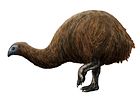
The Gruiformes are an order containing a considerable number of living and extinct bird families, with a widespread geographical diversity. Gruiform means "crane-like".

Sagittariidae is a family of raptor with one living species—the secretarybird native to Africa—and a few fossil taxa.

Carodnia is an extinct genus of South American ungulate known from the Early Eocene of Brazil, Argentina, and Peru. Carodnia is placed in the order Xenungulata together with Etayoa and Notoetayoa.
Paleontology or palaeontology is the study of prehistoric life forms on Earth through the examination of plant and animal fossils. This includes the study of body fossils, tracks (ichnites), burrows, cast-off parts, fossilised feces (coprolites), palynomorphs and chemical residues. Because humans have encountered fossils for millennia, paleontology has a long history both before and after becoming formalized as a science. This article records significant discoveries and events related to paleontology that occurred or were published in the year 1971.
Paleontology or palaeontology is the study of prehistoric life forms on Earth through the examination of plant and animal fossils. This includes the study of body fossils, tracks (ichnites), burrows, cast-off parts, fossilised feces (coprolites), palynomorphs and chemical residues. Because humans have encountered fossils for millennia, paleontology has a long history both before and after becoming formalized as a science. This article records significant discoveries and events related to paleontology that occurred or were published in the year 1969.

Borealosuchus is an extinct genus of crocodyliforms that lived from the Late Cretaceous to the Eocene in North America. It was named by Christopher Brochu in 1997 for several species that had been assigned to Leidyosuchus. The species assigned to it are: B. sternbergii, the type species, from the Maastrichtian of Colorado, Montana, North Dakota, South Dakota, and Wyoming; B. acutidentatus, from the Paleocene of Saskatchewan; B. formidabilis, from the Paleocene of North Dakota; B. griffithi, from the Paleocene of Alberta; and B. wilsoni, from the Eocene of Wyoming. B. formidabilis is particularly well-known, represented by the remains of many individuals from the Wannagan Creek site in North Dakota. An indeterminate species is known from the Late Cretaceous Demopolis Chalk in Alabama.
Prohesperocyon is an extinct genus of canid, endemic to North America appearing during the Late Eocene around 36.6 mya (AEO).
Cunampaia is a dubious genus of extinct mesoeucrocodylian. Fossils have been found from the Divisadero Largo Formation of Mendoza Province, Argentina, and date back to the Divisaderan to Tinguirirican regional South American Land Mammal Age of the Late Eocene epoch.
The Irdin Manha Formation is a geological formation from the Eocene located in Inner Mongolia, China, a few kilometres south of the Mongolian border.

Baenidae is an extinct family of paracryptodiran turtles known from the Early Cretaceous to Eocene of North America. While during the Early Cretaceous they are found across North America, during the Late Cretaceous they are only found in Laramidia, having disappeared from Appalachia. The majority of lineages survived the K-Pg Extinction, but the family was extinct by the latest Eocene. The name of the type genus, Baena, appears to be of Native American origin, likely from the Arapaho be’enoo. They are primarily found in freshwater deposits, and are considered to be aquatic, with a largely generalist habit.

Bathornithidae is an extinct family of birds from the Eocene to Miocene of North America. Part of Cariamiformes, they are related to the still extant seriemas and the extinct Phorusrhacidae. They were likely similar in habits, being terrestrial, long-legged predators, some of which attained massive sizes.
Cygnus paloregonus is a fossil swan. It is an ancestor of, and distantly allied to, the mute swan. It is known from the Pleistocene from Fossil Lake, Oregon, Froman's Ferry, Idaho, and from Arizona. It is referred to by Hildegarde Howard in Delacour's The Waterfowl of the World as "probably the mute type swan".
Paracrax is a genus of extinct North American flightless birds, possibly related to modern seriemas and the extinct terror birds. Part of Bathornithidae, it is a specialised member of this group, being cursorial carnivores much like their South American cousins, some species attaining massive sizes.
Eutreptornis is a genus of extinct possible cariamiforme bird from the Late Eocene of Utah. It is traditionally considered to be a bathornithid, though a combination of the relative incompleteness of the material alongside some differences from other bathornithids have raised some suspicions about this affiliation.

Bathornis is an extinct lineage of birds related to modern day seriemas, that lived in North America about 37–20 million years ago. Like the closely related and also extinct phorusrhacids, it was a flightless predator, occupying predatory niches in environments classically considered to be dominated by mammals. It was a highly diverse and successful genus, spanning a large number of species that occurred from the Priabonian Eocene to the Burdigalian Miocene epochs.
Minerva is an extinct genus of owls in the prehistoric family Protostrigidae from the Eocene of North America. Described in 1915 by R. W. Shufeldt, some of the bones of Minerva were interpreted as belonging to an edentate mammal by Alexander Wetmore in 1933, who assigned the remaining bones to the new genus Protostrix. Analysis in 1983 re-established the genus Minerva was avian.
Geranoididae is a clade of extinct birds from the early to late Eocene and possibly early Oligocene of North America and Europe. These were mid-sized, long-legged flightless birds. Recent research shows that these birds may actually be palaeognaths related to ostriches.
Araiochelys is an extinct genus of bothremydid pleurodiran turtle that was discovered in the Ouled Abdoun Basin, Morocco. The genus consists solely of type species A. hirayamai.
Podiceps oligoceanus is an extinct species of grebe possibly from the Neogene period which the specimen has been found in the United States.








